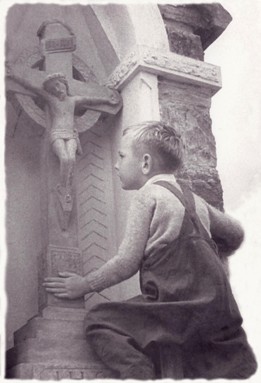Quick Search
Browse:
Town Info:
Internment Camp Memorial Shrine
- Categorized in: Attractions

Internment Camp Memorial Shrine in Harvey, Western Australia has a huge history base beginning in WWII when Mussolini and Hitler joined forces and declared war on Great Britain and France. As a result, all German and Italian migrants living in the allied countries were categorised as enemy aliens, and subsequently interned in camps. One of these camps was situated in Harvey, known as Camp #11 with about 1000 internees.

One of the prisoners instigated the construction of an altar made of stone, depicting the Catholic faith. The shrine still stands today and was enclosed in a chapel in 1992. It is believed to be the only road side shrine of its kind in Australia. Housed in the chapel are several sculptures and an “Australia Remembers” static display. The shrine is a popular tourist attraction depicting an important part of our history. To access the inside of the Internment Camp Memorial Shrine, a key must be collected from the Harvey Visitor Centre along with a small deposit, which will be returned with the return of the key.
The She-Wolf (known as Lupa)
The Internment Camp Shrine houses a replica sculpture of the she-wolf and the two suckling’s Romulus and Remus. Sculptured by a creative Italian internee who coped with the boredom of camp life by exercising his talents.
The legend of Romulus and Remus (the sons of Rea Silva and the god Mars, abandoned on the waters of the Tiber, and suckled by a she-wolf) that Rome derives its symbol. In fact, the she-wolf, an Etruscan work of the first half of the 5th century B.C. can be seen today in the Capitoline Museum in the Palazzo dei Conservatori. Originally the sculpture did not have the two charming “putti” in the act of suckling milk; these were added in the 15th century by the great Florentine sculptor Atonio del Pollaiolo.
There are some theories regarding the origin of the name ‘Rome’. Some scholars maintain that it comes from the word ‘Rumon’, the name used for the River Tiber at the time of the city’s founding. Other scholars tend to identify Rome with the word ‘ruma’ (breast), the name given to the Palatine Hill.
Light House
This sculpture by Dante Giacomel, of a replica Light House was donated to Dr Francis Gordon Stimson for his son Donald Stimson by the internees in 1942. Dr F. G. Stimson was the camp doctor for the duration of hostilities (1939-1945) and was appreciated very much for his caring towards the internees. The sculpture was donated back to the Shrine by the Stimson family. Donald Stimson passed away in 1950. Dr Stimson passed away in 1958 after serving the district since 1934.
Garden Pots
Two garden pots were also produced at the camp. They were in the possession of Mr DM (Mick) Breen who resided in Harvey from 1922 to 1975. Mick passed away 10/7/03 and requested the two pots be returned to the Shrine for historic reference. Delivered to the Shrine by his son David Breen 18/7/2003.
Internment Camp Fountain
The Internment Camp Shrine Committee secured a grant of $20,000 in 2002 to erect a Water Fountain at the Shrine. This project was completed in 2002.
Garry’s Crossing
Along your 200m journey from the Harvey Visitor Centre to the Internment Camp Memorial Shrine you will come across a bridge known as Garry’s Crossing. Many of our visitors ask why it is called this. The name relates to a local – Garry Van Burgel OAM in recognition of the work that he did in assisting with the establishment of the Shire precinct and particularly the crossing over the channel to give direct access between the Visitor Centre and Internment Camp Shrine.
